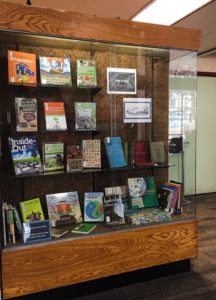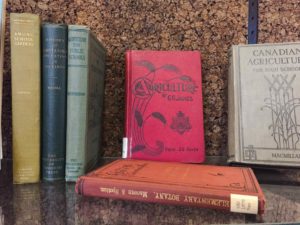Since 2009, Environmental and Sustainability Education (ESE) has been infused in all grade levels and subjects in Ontario schools. (http://www.oise.utoronto.ca/ese/) As part of the celebration, Eco-Fair annual hosts a network of community-based organizations to collectively share organizational initiatives, educational resources, delicious food, and innovative ideas. The goal of the  Eco-Fair is to connect students, faculty, staff, educators, and visitors to ESE resources and initiatives by local community organizations and nonprofit organizations.
Eco-Fair is to connect students, faculty, staff, educators, and visitors to ESE resources and initiatives by local community organizations and nonprofit organizations.
In celebration of the 8th annual OISE Library Eco-Fair, the OISE Library has selected some educational materials on ESE displayed on the ground floor of the OISE Library. By integrating practices of ESE through teaching and learning, students will gain a deeper understanding of the environment to bring a greater level of awareness and action in environmental resilience and sustainability. In the classroom, educators and students can explore relationships between humans and ecosystems with various unique items from the OISE collection.
The display contains a number of books that are valuable resources for educators.  Highlights include, Occupy Education: Living and Learning Sustainability (2012), by Tina Lynn Evans. In this book, Evans applies theory around sustainability into education, specifically sustainability education and social justice.
Highlights include, Occupy Education: Living and Learning Sustainability (2012), by Tina Lynn Evans. In this book, Evans applies theory around sustainability into education, specifically sustainability education and social justice.
In Jumping from the Ivory Tower: Weaving Environmental Leadership and Sustainable Communities (2010), Rosemarie Russo describes the qualities, skills, and behaviors required of environmental educators. Betsy Gunzelmann considers how globally engaged education can provide opportunities to promote diversity and collaboration in the face of risks that students around the world face caused by environmental, political and economic instabilities in Global Voices and Global Visions: Education for Excellence, Understanding, Peace and Sustainability (2014).
 Published by Routledge in 2013, Higher Education for Sustainability: Cases, Challenges, and Opportunities from Across the Curriculum contains a collection of chapters that outline case studies about how sustainable learning outcomes have been applied to curricula and research in higher education. Another collection of scholarship published by Routledge, Science, Society, and Sustainability: Education and Empowerment for an Uncertain World (2009), offers various perspectives on how instruction and learning can be transformed through innovative approaches to science and technology education.
Published by Routledge in 2013, Higher Education for Sustainability: Cases, Challenges, and Opportunities from Across the Curriculum contains a collection of chapters that outline case studies about how sustainable learning outcomes have been applied to curricula and research in higher education. Another collection of scholarship published by Routledge, Science, Society, and Sustainability: Education and Empowerment for an Uncertain World (2009), offers various perspectives on how instruction and learning can be transformed through innovative approaches to science and technology education.
Looking for engaging ways to support and enhance environmental and sustainability education in the classroom? The book display highlights some of OISE Library’s collection of curriculum resources about these topics. Eco-fun: Great Projects, Experiments, and Games for a Greener Earth (2001) by David Suzuki and Kathy Vanderlinden contains forty-eight  science experiments for primary school children. The experiments show children how they can apply science skills to community-based ecology projects. The Environmental Toolkit for Teachers: First Steps to Sustainability (2014) written by Neil Fraser and illustrated by Hanna Forsgren includes a number of fun classroom and school-wide activities. Through these activities, children learn about environmental impact and sustainability. The Garden Classroom: Hands-on Activities in Math, Science, Literacy, and Art (2015) brings the classroom into the garden through a number of hands-on activities.
science experiments for primary school children. The experiments show children how they can apply science skills to community-based ecology projects. The Environmental Toolkit for Teachers: First Steps to Sustainability (2014) written by Neil Fraser and illustrated by Hanna Forsgren includes a number of fun classroom and school-wide activities. Through these activities, children learn about environmental impact and sustainability. The Garden Classroom: Hands-on Activities in Math, Science, Literacy, and Art (2015) brings the classroom into the garden through a number of hands-on activities.
 Creative ways to explore sustainability and the environment can be found in We Are the Weather Makers: The History of Climate Change (2009). This book provides a thorough examination on the ways that humans are altering our planet. Chapters include “calls to action” that suggest ways to address climate change. Environment Infographics (2014) uses graphic representations to provide information about how to address climate change, pollution, energy consumption, and other risks to the environment.
Creative ways to explore sustainability and the environment can be found in We Are the Weather Makers: The History of Climate Change (2009). This book provides a thorough examination on the ways that humans are altering our planet. Chapters include “calls to action” that suggest ways to address climate change. Environment Infographics (2014) uses graphic representations to provide information about how to address climate change, pollution, energy consumption, and other risks to the environment.
Bring story and adventure into the classroom with books from OISE Library’s Children’s  Literature collection. In Where Once There Was a Wood (1996) Denise Fleming’s illustrations show the threats that development pose on wildlife and their fragile habitats, while showing how communities and schools can play a role in addressing these risks. Eco Warrior (2015), and Miracle at Willowcreek (1998) offer two very different stories about characters that seek to protect wildlife in their habitat.
Literature collection. In Where Once There Was a Wood (1996) Denise Fleming’s illustrations show the threats that development pose on wildlife and their fragile habitats, while showing how communities and schools can play a role in addressing these risks. Eco Warrior (2015), and Miracle at Willowcreek (1998) offer two very different stories about characters that seek to protect wildlife in their habitat.
The display also includes hands-on manipulatives for the classroom. Pollution Solution: The Game of Environmental Impact, Keep it Green: A Discovery Game for Environmental Consciousness, and The Green House Game: The Environmental Game are fun and interactive ways to promote sustainable practices and environmental awareness.
 The Ontario Historical Education Collection has an impressive collection of past textbooks on the education of agriculture and gardening in Canada. The display contains a sample of these textbooks that will inspire you to explore how agriculture was taught in Canadian schools during the 18th and early 19th centuries.
The Ontario Historical Education Collection has an impressive collection of past textbooks on the education of agriculture and gardening in Canada. The display contains a sample of these textbooks that will inspire you to explore how agriculture was taught in Canadian schools during the 18th and early 19th centuries.
For more suggested materials, please visit the OISE LIbrary display located on the ground floor of the OISE Library.
